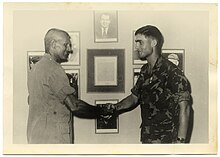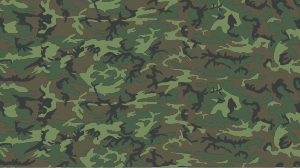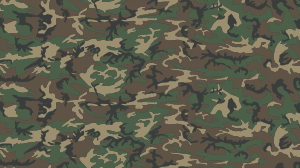|
ERDL pattern
The ERDL pattern, also known as the Leaf pattern,[2] is a camouflage pattern developed by the United States Army at its Engineer Research & Development Laboratories (ERDL) in 1948.[3][4] It was not used until the Vietnam War, when it was issued to elite reconnaissance and special operations units beginning early 1967.[5][6] The pattern consists of four colors printed in an interlocking pattern. It was initially produced in a green-dominant colorway, consisting of large organic shapes in olive green and brown, black 'branches' and light green 'leaf highlights'. Shortly after it was first fielded in Vietnam a brown-dominant scheme with the light green replaced by light tan was introduced. History
 The United States Marine Corps (USMC) adopted the green-dominant version as standard issue in South Vietnam in 1968, and later the U.S. Army introduced it on a wide scale in Southeast Asia. The ERDL-pattern combat uniform was identical in cut to the OG-107 Tropical Combat uniform, commonly called "jungle fatigues", it was issued alongside.[7] It was common for marines to wear mixes of ERDL and OG-107 jungle fatigues, which was authorized owing to periodic shortages. Australian and New Zealand SAS members were also issued U.S.-spec tropical combat uniforms in ERDL during their time in the Vietnam War. By the end of the Vietnam War, U.S. servicemen wore camouflage combat dress as the norm.[8] Following the withdrawal of the U.S. military from South Vietnam in 1973, the U.S. Army ceased routine issue of camouflage clothing. The 1st Battalion, 13th Infantry Regiment wore the ERDL pattern as an experiment from January 1973 to 1974[9] in Baumholder, Germany. In 1976, the Marines obtained the leftover Vietnam War-era ERDL pattern uniforms which became general issue,[citation needed] replacing the solid OG-107 sateen utility/fatigue uniform. The uniform was used to equip the United States Rapid Deployment Force (RDF) while on tropical missions. Photographs during the 1979 Iranian hostage crisis show U.S. marines guarding the U.S. embassy wearing the RDF version ERDL uniforms when they were taken hostage by Iranian revolutionaries.[citation needed] It was not until 1981 that the Army approved another camouflaged uniform. That year it officially introduced the M81 Battle Dress Uniform (BDU) in a four-color woodland pattern,[10] an enlarged and slightly altered version of ERDL, to supply all arms of the U.S. military. Despite being phased-out after that date, the ERDL pattern continued to see service up into the 1990s. ERDL was notably seen being worn by various US troops during the Invasion of Panama and seen in 1996 during US peacekeeping operations in Africa.[11] Garment types, designs, and use in Southeast Asia (1967–72)The ERDL pattern was used on official and unofficial U.S. military garments in Southeast Asia (SEA), in both ground and aviation garment versions, from 1967 to the war's end. Early production on the ERDL ran into problems due to roller slippage, which results in inconsistencies with the patterns that were printed.[4] On official ground combat garments, the ERDL pattern was first applied to the third model Tropical Combat Uniform around 1967, and was printed onto a lightweight cotton poplin textile material. This poplin uniform was very short-lived, but it did see combat use in SEA by various U.S. special operations and some other units. Soon afterward, the ERDL pattern was printed onto the standard rip-stop cotton textile material. This ERDL rip-stop cotton Tropical Combat Uniform version thus saw wide use in SEA after 1968, with special operations units and also regular units, especially as ground combat operations continued throughout the war up to late 1972. On official aviation combat garments, the ERDL pattern was used on the USAF Type K-2B flying coveralls, in a cotton poplin textile version. The USAF ERDL coveralls saw some use in SEA from 1967 to 1969, until replaced by Nomex coveralls in 1970. The U.S. Navy also produced an official ERDL aviation garment in their MIL-C-5390G pattern, produced in a cotton twill textile. These Navy ERDL coveralls saw very limited SEA use from 1967 to 1968, as their Nomex coveralls were already in use. On unofficial and commercial garments, the ERDL pattern was copied and used by U.S. commercial textile manufacturers in the late 1960s, and applied to various commercial camouflage garments for hunting or unofficial military use. Some commercial ERDL garment examples were made using cotton poplin material, and others were made in the standard rip-stop cotton material. Many commercial ERDL garment examples of the time were made in the pattern mirroring the standard OG-107 fatigue uniforms, with a standard tucked-in shirt, and conventional trousers design. These commercial ERDL OG-107 fatigue-style garments did see some combat use in SEA, such as with U.S. Navy tactical jet aviators in the 1968 timeframe. Some USAF aviators also purchased locally tailor-made ERDL garments for combat and off-duty use. Additionally, some tropical combat uniforms were made by local tailors in the ERDL rip-stop material, which were particularly useful when a classified mission required the use of 'sanitized' or 'sterile' apparel, and equipment. UsersCurrent
Former
Non-state actors
References
Further reading
External links
|
||||||||||||||||||||||||||


